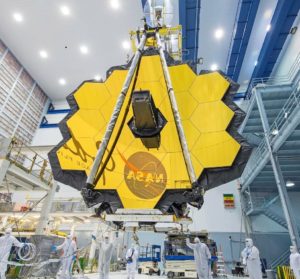 It cost 10 billion bucks, and is 14 years behind schedule, but the James Webb Space Telescope will finally launch into space on October 31, 2021.
It cost 10 billion bucks, and is 14 years behind schedule, but the James Webb Space Telescope will finally launch into space on October 31, 2021.
No wait, that date is now December 18, 2021, which probably should be considered as tentative, too.
In the early days of science, gentlemen astronomers built telescopes with their own funds, some pretty large, and made significant discoveries. Humanity’s basic knowledge about the solar system and stars was put together before the 20th century when big professional telescopes began to appear. Nowadays, research astronomy is all professional.
World-class telescopes are kind of out of reach for ordinary folks, even relatively well-heeled ones. The latest, largest, ground-based telescope (details here) — currently under construction — will cost over $1 billion. It’s situated in the high deserts of Chile, to minimize atmospheric distortion and light pollution. In today’s world, the latter interferes with celestial observing nearly everywhere. Some of the older ones, cutting-edge when built, are now being decommissioned or repurposed (see example here).
There’s still a role for ground telescopes, but to probe into really deep space, you must get above the earth’s atmosphere by going into space. That’s what the Hubble Space Telescope, the first major space-based telescope, did. The JWST will take that to the next level, if it ever makes it off the launchpad, and there are no snafus, because once in solar orbit it will be beyond reach and unrepairable. (The Hubble needed repairs; the JWST better not.)
For details of what the JWST can see, that Hubble cannot, read this article. Obviously, there’s no point in spending that kind of money to see what’s already been seen; as the article says, “The Webb … will allow astronomers to look not only farther out in space but also further back in time: It will search for the first stars and galaxies of the universe. … The Webb is a machine for answering unanswered questions about the universe, for exploring what has been unexplorable until now.” In other words, adding to our knowledge of what’s out there, and the history of the present universe.
 If the JWST works, it’ll be interesting. If it’s a dud, or crashes and burns on the launch pad, it’ll be a cold day in the center of the sun before NASA gets billions of taxpayer dollars to build another one. Meanwhile, for about the cost of a good new car, you too can be a gentleman astronomer, and see what the gentlemen saw in the 18th and 19th centuries.
If the JWST works, it’ll be interesting. If it’s a dud, or crashes and burns on the launch pad, it’ll be a cold day in the center of the sun before NASA gets billions of taxpayer dollars to build another one. Meanwhile, for about the cost of a good new car, you too can be a gentleman astronomer, and see what the gentlemen saw in the 18th and 19th centuries.
Photos: Above, not 10 billion bucks, but not cheap either; bottom, definitely not cheap at 10 billion bucks, but can see a lot farther and a lot more.